
The Great Western Railway (GWR) was a British railway company that linked London with the southwest, west and West Midlands of England and most of Wales. It was founded in 1833, received its enabling act of Parliament on 31 August 1835 and ran its first trains in 1838 with the initial route completed between London and Bristol in 1841. It was engineered by Isambard Kingdom Brunel, who chose a broad gauge of 7 ft —later slightly widened to 7 ft 1⁄4 in —but, from 1854, a series of amalgamations saw it also operate 4 ft 8+1⁄2 in standard-gauge trains; the last broad-gauge services were operated in 1892.

The Severn Valley Railway is a standard gauge heritage railway in Shropshire and Worcestershire, England, named after the company that originally built the railway over which it now operates. The 16-mile (26 km) heritage line runs from Bridgnorth to Kidderminster, following the course of the River Severn along the Severn Valley for much of its route, and crossing the river on the historic Victoria Bridge.
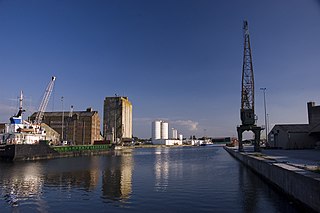
Sharpness is a port in the civil parish of Hinton, in the Stroud district, in Gloucestershire, England, one of the most inland in Britain, and eighth largest in the South West England region. It is on the River Severn at grid reference SO669027, at a point where the tidal range, though less than at Avonmouth downstream, is still large.
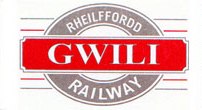
The Gwili Railway is a Welsh heritage railway, that operates a preserved standard gauge railway line from the site of Abergwili Junction in southwest Wales along a four-and-a-half-mile (7.2 km) section of the former Carmarthen to Aberystwyth line. The original railway closed in 1965, with the track being lifted in 1975.

Lydney railway station is a railway station serving the town of Lydney in Gloucestershire, England. It is located on the Gloucester-Newport line, 133 miles 37 chains (214.8 km) from the zero point at Paddington, measured via Stroud. The station is located a mile south of Lydney, and was originally called Lydney Junction, which is now the name of the nearby station on the preserved Dean Forest Railway.
The Bristol and Gloucester Railway was a railway company opened in 1844 to run services between Bristol and Gloucester. It was built on the 7 ftBrunel gauge, but it was acquired in 1845 by the 4 ft 8+1⁄2 instandard gauge Midland Railway, which also acquired the Birmingham and Gloucester Railway at the same time.
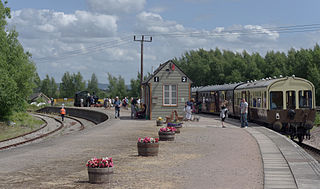
Lydney Junction railway station is a railway station near Lydney in Gloucestershire. The station is now the southern terminus of the Dean Forest Railway. It is located to the south of Lydney, near the A48 road.
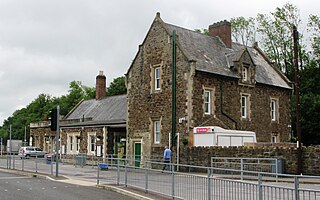
Barnstaple railway station is the northern terminus of the Tarka Line and serves the town of Barnstaple, Devon. It is 39 miles 75 chains (64.3 km) from Exeter Central and 211.25 miles (339.97 km) from London Waterloo. It is managed by Great Western Railway, which also operates the passenger service.

The Portishead Railway is a branch line railway running from Portishead in North Somerset to the main line immediately west of Bristol, England. It was constructed by the Bristol & Portishead Pier and Railway Company, but it was always operated by its main line neighbour, and was more usually thought of as the Portishead branch or the Portishead railway.

Avonmouth railway station is located on the Severn Beach Line and serves the district of Avonmouth in Bristol, England. It is 9.0 miles (14.5 km) from Bristol Temple Meads. Its three letter station code is AVN. The station has two platforms, on either side of two running lines. As of 2015 it is managed by Great Western Railway, which is the third franchise to be responsible for the station since privatisation in 1997. They provide all train services at the station, mainly a train every 30 minutes to Bristol Temple Meads and one every hour to Severn Beach.
The South Wales Railway was a main line railway which opened in stages from 1850, connecting the Great Western Railway from Gloucester to South Wales. It was constructed on the broad gauge. An original aspiration was to reach Fishguard to engender an Irish ferry transit and transatlantic trade, but the latter did not materialise for many years, and never became an important sector of the business. Neyland was the western terminus of the line until 1906.
The Rhondda and Swansea Bay Railway was a Welsh railway company formed to connect the upper end of the Rhondda Fawr with Swansea, with the chief objective of transporting coal and other minerals to Swansea docks. It was incorporated in 1882, but at first the connection to Swansea from Briton Ferry was refused.

The Severn and Wye Railway began as an early tramroad network established in the Forest of Dean to facilitate the carriage of minerals to watercourses for onward conveyance. It was based on Lydney, where a small harbour was constructed, and opened its line to Parkend in 1810. It was progressively extended northwards, and a second line, the Mineral Loop was opened to connect newly opened mineral workings.

Challow railway station is a former railway station about 2 miles (3 km) south of Stanford in the Vale on the A417 road between Wantage and Faringdon. It is named after the villages of West Challow and East Challow, which are 1.5 miles (2.4 km) and 2.5 miles (4 km) southeast of the former station.
The Port Talbot Railway and Docks Company (PTR&D) was formed in 1894 to secure the means of bringing minerals, chiefly coal, to the harbour in South Wales. It took over the docks at Port Talbot that had been operated by the Port Talbot Company. It opened its main line in 1897 and reached a connection with the Great Western Railway Garw Valley line the following year. A branch line to collieries near Tonmawr also opened in 1898. The lines were extremely steeply graded and operation was difficult and expensive, but the company was successful. Passenger operation on the main line started in 1898, but this was never a principal part of the business. For some time most of the passenger train service was operated by a railmotor that was the largest ever to work in the United Kingdom. Also in 1898 the Ogmore Valleys Extension (OVE) line, a part of the PTR&D, was opened. It had been projected as a defensive measure against competitive incursion, and it led from Margam Junction towards Tondu.

The Helston Railway is a heritage railway in Cornwall which aims to rebuild and preserve as much as possible of the former GWR Helston Railway between Nancegollen and Water-Ma-Trout on the outskirts of Helston. It is operated by the Helston Railway Preservation Company using members of the Helston Railway Preservation Society.

Berkeley railway station served the town of Berkeley in Gloucestershire, England. The station was on the Sharpness Branch Line, part of the Midland Railway (MR), which connected the Bristol and Gloucester Railway main line at Berkeley Road station with the docks at Sharpness.
Sharpness railway station served the village and docks of Sharpness in Gloucestershire, England from 1875 to 1964.

The Severn Bridge Railway was a railway company which constructed a railway from Lydney to Sharpness in Gloucestershire, England. It was intended chiefly to give access for minerals in the Forest of Dean to Sharpness Docks, and the company built a long bridge, 1,387 yards (1,268 m) in length, over the River Severn. The line opened in 1879.
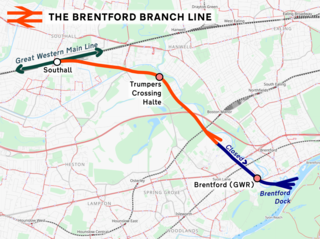
The Brentford branch line, also known as the Brentford Dock Line, is a freight-only branch railway line in west London, England. The route, which opened in 1859, was backed by the Great Western Railway and built by the Great Western & Brentford Railway Company. It ran 4 mi (6.4 km) from Southall to Brentford Dock. In 1964, the line to the wharves was closed. The branch now runs from the Great Western Main Line to a goods yard and waste transfer station in Brentford.















